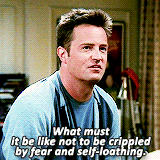A typical lunch for me consists of a venti Starbucks creation, a freshly ordered salad, and a table's circumference full of friends all actively throwing shade. I think it's safe to assume that we all have thrown shade, called someone shady, or have seen some shady activity online. The interesting thing is that, while the word shade saturates our social spheres, many don't know that this word comes from queer culture. There are a lot more elements in mainstream media with roots in the queer community than most people realize.
Whether it's throwing shade, beating your mug, spilling the T, gagging over something, commenting yasss, calling someone queen, or replying with a tongue pop, this hefty list hardly does justice to the amount of stealing that heteronormative society does from queer culture. I call it stealing because, as mentioned before, many don't know where this colorful vocabulary comes from. I didn't know where these words came from until I took an intro to LGBT studies course. But you don't have to devote a semester of your college career to see the plagiarism that occurs daily.
I write this article in order to highlight some points of pop culture where queer culture exists, but its roots are erased. I hope that by the end of this piece, you have a richer appreciation and enjoyment of the deathdrops, lip-syncs, and rest of the colorful culture that continues to fight daily for equality, not inclusion.
Spike TV's Lip Sync Battle can't compare to these Queen
We were amazed, laughing, and speechless at seeing this icon of masculinity adorn female regalia. Yet, this is nothing new to viewers of Logo's juggernaut Ru Paul's Drag Race. A core part of Drag Race is when two queens at risk of being sent home must impress the panel with a lip sync in order to continue in the competition. While Drag Race has been around since 2002, Lip Sync Battle barely debuted in 2015. Go on YouTube and Google "lip sync for your life." After viewing a lip sync between queens and comparing it to Spike's performances, it's obvious that Lip Sync Battle is the party city version of Ru Paul's Drag Race.
Hope you have your library card, because we're reading major news and the library is always open.

Those deathtraps and dances do more than just entertain.
A lot of Channing Tatum in this article, huh? Well luckily he's helping my point! Recently, I have seen that voguing has become a popular fad to follow. Whether it's people posting themselves giving us a nice little sashay or sharing others slaying the crowd, many don't know where this dance comes from. Thanks to the documentary Paris is Burning (1990), and my trusty note taking, I can share what I know about this expressive art. Voguing is the physical form of shade, it echoes Egyptian hieroglyphics, Vogue magazine, but nothing from Madonna. In fact, Madonna stole this dance and capitalized on it. Below are examples of expertise in voguing:
It takes precision:
What to leave with.
To reiterate, I am not a scholar in queer culture, pop culture, or any of that, but I am an individual who can connect the dots. As recent events in Orlando remind us, queer people live under constant attack. This can come from the outside, but also inside this community as well. As heteronormative society steals, and attempts to include queer people in their realm, the reality is that queer people of color, just like heterosexual people of color, are still excluded.
The modern stealing of elements of queer culture even has a name, its called cultural appropriation. This stealing of culture and making an identity marketable doesn't just happen to the queer community, but also to African American, Latin, Asian, and many other cultures as well. Keep in mind the difference between appropriation and appreciation is that in the latter, we are educated and know the history of the culture we are practicing.
This article's purpose was to leave you with a little background on the popular trends you've noticed so that you can now appreciate them for what they're really worth. I hope this sparks an interest in not just looking up more of these points, but in also thinking about what else in our world was stolen without credit.














































